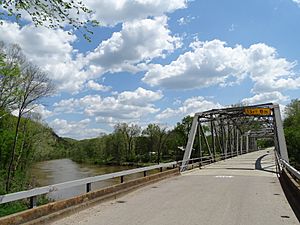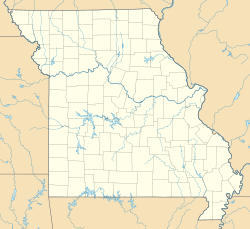Devils Elbow, Missouri facts for kids
Quick facts for kids
Devils Elbow, Missouri
|
|
|---|---|

Devils Elbow Bridge
|
|
| Country | United States |
| State | Missouri |
| County | Pulaski |
| Elevation | 748 ft (228 m) |
| GNIS feature ID | 749642 |
Devils Elbow is a small community in Pulaski County, Missouri. It's famous for being on the historic U.S. Highway 66. It sits right by the Big Piney River. The river makes a very sharp turn here. People thought this bend looked like a "devil of an elbow." That's how the community got its name! It's about five miles (8 km) east of St. Robert.
Contents
History of Devils Elbow
How Devils Elbow Got Its Name
Long ago, in the 1800s and early 1900s, people cut down trees upstream. They floated logs and railroad ties down the Big Piney River. But they had to get past a very sharp bend in the river. Sometimes, their rafts would break apart there. So, the loggers called this tricky spot the "Devil's Elbow." The community of Devils Elbow grew up right inside this famous river bend.
A Popular Spot for Fun
Even in the late 1800s, Devils Elbow was a favorite place for people from St. Louis. They came to fish in the Big Piney River. The forests around the area were great for hunting too. At first, visitors arrived by train and then by wagon. Later, cars used State Highway 14, which was a mix of gravel and dirt roads.
Route 66 Comes to Town
In 1923, a cool steel bridge was built over the Big Piney River. This bridge was part of State Highway 14. Then, in 1926, Highway 14 became the famous U.S. Route 66.
In 1927, the Devils Elbow post office opened. Soon, places like Graham’s Resort and Camp appeared. The Munger-Moss Sandwich Shop and the Devil's Elbow Cafe were also built. These spots offered food and cabins for tourists traveling on Route 66. By the 1930s, Devils Elbow was a popular stop on the "Mother Road." Its beautiful cliffs were even called one of Missouri's top seven beauty spots.
Changes Over Time
During World War II, a military base called Fort Leonard Wood was built nearby. This brought many more people to Devils Elbow. More cabins and houses were built. But after 1945, a new, wider part of Route 66 opened. This new road bypassed Devils Elbow. So, less traffic came through the community.
Today, many fans of historic Route 66 still visit Devils Elbow. They love to see the original 1926 route and the famous bridge.
Saving the Historic Bridge
The bridge at Devils Elbow is very special. It's one of only two bridges left on Route 66 with a "dogleg" (a curve). It's also the only one still open for cars. Over the years, the bridge started to show its age. It needed a lot of repairs.
Since Route 66 was no longer a federal highway, Pulaski County became responsible for the bridge. In 2002, county leaders decided to save it. The repairs were very expensive. Many different groups helped raise money for the project. These included federal and state government agencies.
Finally, on October 24, 2013, work began to fix the bridge. It cost $1.3 million. The repairs were finished, and the bridge reopened on May 22, 2014. This project showed how people can work together to save important historical places.
Devils Elbow Becomes a Historic District
In April 2017, the area around Devils Elbow was recognized as a special place. It was added to the National Register of Historic Places. This means the bridge, old roads, and other buildings are now protected. They are part of the "Devil’s Elbow Historic District."
Getting Around Devils Elbow
Main Roads
The main highway that goes east and west is Interstate 44. Before I-44 was built, U.S. Route 66 was the main road. Route 66 still exists as a scenic route. It passes through Devils Elbow and other nearby towns.
Route 66 has different names in different spots. You might hear it called Teardrop Road, Highway Z, Old Route 66, or Historic Route 66. Signs usually mark where the old road goes.
The Bridges of Devils Elbow
There are three bridges that cross the Big Piney River at Devils Elbow:
- The modern Interstate 44 bridge.
- The later U.S. Route 66 bridge on Highway Z. This road was made possible by a big cut through a hill called the Hooker Cut.
- The original U.S. Route 66 bridge on Teardrop Road. This is the historic bridge that was recently renovated.


